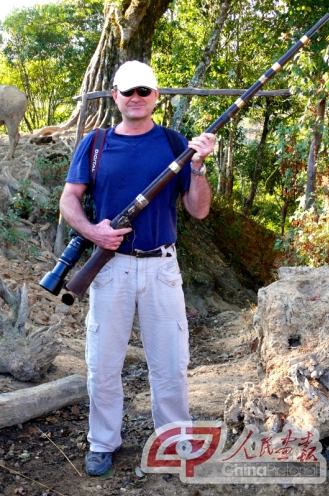Destination southern Yunnan through a western lens
| Gracious Greeting – High mountain village. |
Outside the small city of Jinghong, southernmost Yunnan Province, near the Lao border, gorgeous garb and graceful gals at a festival gathering members of the Hani, Aini, and Akha ethnic groups.
Banna Backwoods
If you are strictly accustomed to four and five-star accommodations and don't like the idea of sleeping in the open air on a mat spread across a rough wood deck, stay in town. Similarly, if you tire easily or if your feet are not capable of treading narrow, rocky, very steep and sometimes precarious mountain trails, do yourself and those who may otherwise accompany you a favor: Take a vehicle-based day tour to the nature reserve, have a look at the elephants, visit a local spa, get a massage, sip a few cold beers poolside back at the hotel.
The Banna style of trekking is no walk in the park. Hikes between village stops are measured in the tens of kilometers, and level strolling is the exception. Having reasonably good stamina, I reached more than one peak at high altitude, only to be maxed out; my lungs heaving for oxygen.
That warning issued – Getting all the way to Banna and not trekking would be like boating to the Great Barrier Reef and passing on the scuba diving. Following a qualified, multi-dialect local guide, you can trial-run the backcountry for an overnighter, or wander more remote areas for several days. During that time, expect no conveniences other than what you pack on your back. And don't make the mistake (like I did) of assuming plenty of bottled water will be had in the villages along the way. Stock up; carry all the H20 you can.
Food, on the other hand, you don't have to worry about. Lunch and dinner will be waiting in villages along the way, as cooked over an open fire within a local's above-ground hut. The raw product, of course, will be completely fresh and organic, grown and raised in the immediate forested vicinity.
Ethnic Ethics
If you are an enthusiastic eater of pork, like roasted and added to fresh greens, you'll get a bonus on this trek. While it lasts, around here that particular raw product lives a pretty good life. Snoozing, slopping, snorting and generally messing around, the pigs happily wander free throughout the mountainous forest – on rare occasions perhaps pausing in their meandering patrol of the trail to sniff at the air and examine the odd smelling foreign human. Seemingly okay with their deal in and of life, at the end of the day they return home to flop beneath their owner's hut. There must be a certain ethnic ethic among the varying villages here, for none seem concerned that their particular swine may anonymously end up on a neighbor's dinner plate at the end of the day.
Xishuangbanna is also well known for its many and diverse ethic groups. Besides the majority Dai, at about 30 percent of the population, there are more than 43 other unique peoples here, including the Hani, Yi, Lahu, Blang, Jino, Yao, Miao, Bai, Hui, Wa, and Zhuang. Most maintain their own customs, dialect, and colorful traditional garb and adornments. Besides visiting with them in the course of trekking, ethnic tours are easily booked, or, if you are more independent-minded and reasonably fit, grab a map, rent a mountain bike and hit the trail by the river, the Mekong.
| Photographer Armed – Used only for hunting … I think, this real, working and loaded single-shot antique flintlock was momentarily borrowed from a local along a high-mountain and very remote trail near the Myanmar border. |
 0 Comments
0 Comments










Comments